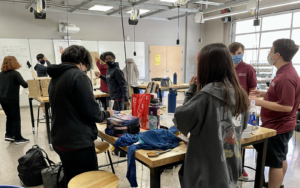Putting the Science of Learning and Development Into Action

“Imagine a world in which every child’s life is a succession of positive opportunities for development—opportunities through which a child can come to know who they are and discover the wide range of possibilities for what they can become. Imagine different types of learning settings in which those kinds of opportunities are also intentionally built and optimized, regardless of where a child lives or attends school. Imagine, too, that educators can identify each child’s talents, interests, and aspirations and align them with learning opportunities designed to promote them and build on them to create new competencies.”
-A New Purpose for Education, Design Principles for Schools
A new book offers a blueprint for elementary and secondary education. Design Principles for Schools: Putting the Science of Learning and Development Into Action was published by Learning Policy Institute and Turnaround for Children in partnership with the Forum for Youth Investment and in association with the SoLD Alliance.
The education system we inherited evolved over time—it was not designed for equitable whole child development. The pandemic, the recession, the impact of the climate crisis, and racialized violence laid bare the inequities of experience and opportunity for many young people. Design Principles for Schools outlines the opportunity to intentionally shape experiences and environments for equity.
The book frames the opportunity we have today: “Developmental and learning science tell an optimistic story about what all young people are capable of.” We have an opportunity to “design a system in which all individuals are able to take advantage of high-quality opportunities for transformative learning and development.”
The five design principles include:
- Positive Developmental Relationships
- Environments Filled With Safety and Belonging
- Rich Learning Experiences and Knowledge Development
- Development of Skills, Habits, and Mindsets
- Integrated Support Systems

The design principles don’t suggest a single learning model but they do suggest a very different set of experiences and environments for most learners. Redesign around the Design Principles creates conditions that “support the talents and agency of each child; respect the culture and assets of the community; and create personalized opportunities for growth.”
Redesign requires a commitment to equity and sustained developmental relationships. The book includes a number of case studies and resources that support each of the design principles.
New Learning Goals in Six Domains
The design principles are intended to advance an updated set of goals for youth learning and development. Organized in six domains identified by the Chan Zuckerberg Initiative, the whole child development goals draw inspiration from a number of respected outcome frameworks.
- Cognitive development: Learners can think critically and creatively to solve complex problems.
- Academic development: Learners deeply understand content and can apply their knowledge beyond the classroom.
- Social and emotional development: Learners are self-aware and engage meaningfully with others.
- Identity development: Learners hold a positive sense of identity, self-potential, purpose, and direction.
- Physical and mental well-being: Learners make healthy life choices.
- Ethical and moral development: Learners are empathetic, ethical, and proactive in contributing to the welfare of their communities.
The goals are comprehensive, cross-cutting and integrative. They are notable and unique in several important ways for any school system developing a portrait of a graduate or reconsidering learning goals.
The cognitive goals focus on complex problem solving and working “toward meaningful personal and collective goals with a strong sense of agency and purpose.”
The inclusion of the ethical and moral development domain emphasizes “that individual goals are connected to larger community aims and elevate the civic mission of education.”
Identity development includes a positive self-image including “a sense of agency and the ability to make choices grounded in their values and take an active role in their life paths,” and “the ability to see themselves as a vital part of their communities and as having value and making a unique and fruitful contribution to their communities.”
The wellbeing goal includes access to healthy enabling conditions and encourages the development of lifelong patterns of healthy behavior, while perspective-taking, appreciating diversity, and negotiating conflict constructively were added to social and emotional development.
The book is a must-read for any education leader interested in developing a whole child agenda. It is comprehensive and specific about the changes that will benefit all learners.
For more, see:
- Processes and Principles for Public Schools Navigating Uncertainty and Adapting to Change
- Five Principles to Help Provide Our School Communities With the Communications They Deserve
Stay in-the-know with innovations in learning by signing up for the weekly Smart Update.
This post was originally published on Forbes.








0 Comments
Leave a Comment
Your email address will not be published. All fields are required.